According to the Alzheimer’s Association “several conditions known to increase the risk of cardiovascular disease — such as high blood pressure, diabetes and high cholesterol — also increase the risk of developing Alzheimer’s. Some autopsy studies show that as many as 80 percent of individuals with Alzheimer’s disease also have cardiovascular disease.”
We know what causes cardiovascular disease and how to prevent and reverse it. We can apply this same knowledge to prevent or slow the progression of Alzheimer’s disease.
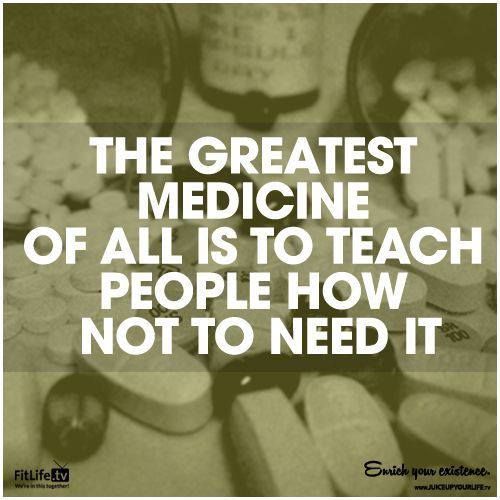
Definition: While cardiovascular disease can refer to different heart or blood vessel problems, the term is often used to mean damage to your heart or blood vessels by atherosclerosis, a buildup of fatty plaques in your arteries. Plaque buildup thickens and stiffens artery walls, which can inhibit blood flow through the arteries to your organs and tissues.
Atherosclerosis is also the most common cause of cardiovascular disease. It can be caused by correctable problems, such as an unhealthy diet, lack of exercise, being overweight, and smoking. (source)
If we know how to prevent and reverse heart disease, we can prevent and, if not reverse, halt the progression of Alzheimer’s disease.

Digest these facts: (source)
• more than 5 million American are living with Alzheimer’s
• every 67 seconds someone in the United States develops Alzheimer’s
• Alzheimer’s disease is the 6th leading cause of death in the United States
• there are approximately half a million people dying each year due to Alzheimer’s
• 1 in 3 seniors die with Alzheimer’s or another form of dementia
• almost 2/3 of Americans with Alzheimer’s are women
Leading causes of death: (source)
1. Heart disease: 611,105
2. Cancer: 584,881
3. Chronic lower respiratory diseases (COPD – emphysema, chronic bronchitis): 149,205
4. Accidents (unintentional injuries): 130,557
5. Stroke (cerebrovascular diseases): 128,978
6. Alzheimer’s disease: 84,767
7. Diabetes: 75,578
8. Influenza and Pneumonia: 56,979
9. Nephritis, nephrotic syndrome, and nephrosis (kidney disease): 47,112
10. Intentional self-harm (suicide): 41,149
Isn’t it amazing that nine of these above are largely preventable (except #4) and eight are largely reversible (except #4 and #10)?
The below excerpt is from an interview with Dr. Pam Popper in her new book Food Over Medicine:
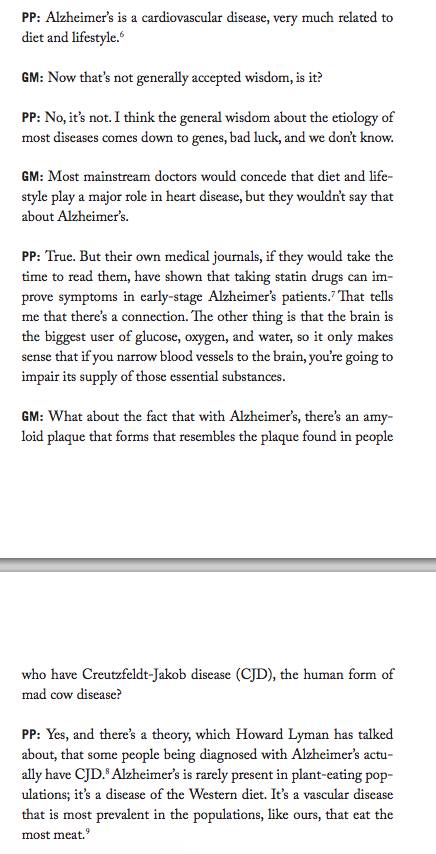
Do this right now:
1. Go to BenBella Vegan book publishers website.
2. Sign up for their newsletter (you can unsubscribe at any time) and receive the below free ebook with 50 plant-based recipes and excerpts from books by Dr. Pam Popper and Dr. T. Colin Campbell, two leading experts in the field of disease prevention using nutrition.

3. Scroll down to page 108 of the free PDF ebook and read the entire excerpt from Dr. Pam Popper’s book. It’s Chapter 3 which is titled “Diseases and the Foods that Bring Them On.” (The above GM/PP interview excerpt is from this chapter.)
4. Next, listen to the Rich Roll podcast interview of Dr. Joel Kahn, cardiologist, titled “Is Butter Really Back?” America’s #1 killer, heart disease currently kills 1 out of every 3 Americans; 70% of Americans are obese and getting fatter; and studies forecast that by 2030, 50% of Americans will be diabetic or pre-diabetic. The great irony in all of this is that, as Dr. Kahn so astutely points out, 80-90% of all chronic health problems can be resolved via pretty simple diet and lifestyle alternations.
If you wish to prevent disease or reverse the symptoms of a disease that you currently have, heart disease, Alzheimer’s or otherwise, you must adopt a whole food, plant-based, naturally low-fat diet in order to give your body the best chance of being well & healing. Skipping this large step is simply foolish. There are so many books on the market now about the topic, so many useful websites, and a bounty of cookbooks to make this lifestyle easy, enjoyable, and effective.
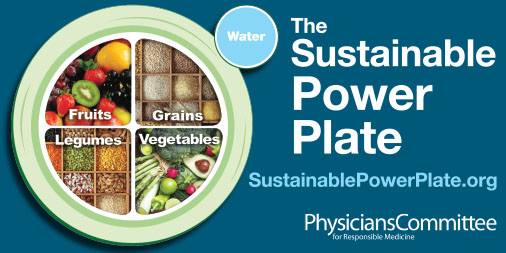
The BenBella free ebook will get you started with recipes. Here are some other sources for naturally low-fat, whole food, plant-based recipes:
1. Forks Over Knives
2. Physicians Committee for Responsible Medicine
4. The Campbell Plan
5. Chef Del’s Better than Vegan
6. The China Study
These above are all cooked vegan recipes, with many raw fruits and veggies. There is an entirely separate niche of low-fat all raw vegan recipes and sources.
The keys to all of these food preparation recommendations are:
#1: whole, real food;
#2: plant-based, and
#3: naturally low in whole plant fat.
Whether the recipes are mostly raw or not is based on your preference & nutritional beliefs. There are many raw vegan resources but they tend to be high in fat from avocado, coconut, oil, and nuts. This is not a wise choice. Look for low-fat raw vegan sources instead if you favor the raw, uncooked, living enzyme approach.
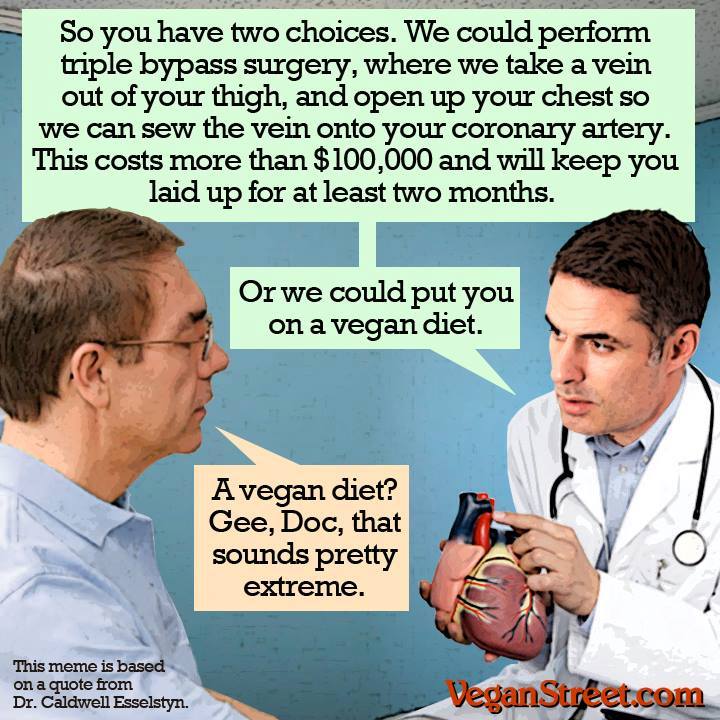
These are excellent doctors and nutritionists to follow. They are the ones helping to reverse and prevent diseases with diet:
1. Dr. Caldwell Esselstyn & Rip Esselstyn
2. Dr. T. Colin Campbell & Dr. Thomas Campbell
9. Dr. Jeff Novick
Together with quitting smoking and avoiding second-hand tobacco smoke, exercising regularly (30 minutes a day, 3-5 days per week), maintaining a healthy weight, sleeping adequately, avoiding drugs (prescription, recreational, over-the-counter), and drinking alcohol minimally or not at all, eating a whole food, naturally low-fat, plant-based diet is the most powerful choice you can make to restore, protect, and fortify your good health for a long, enjoyable life.
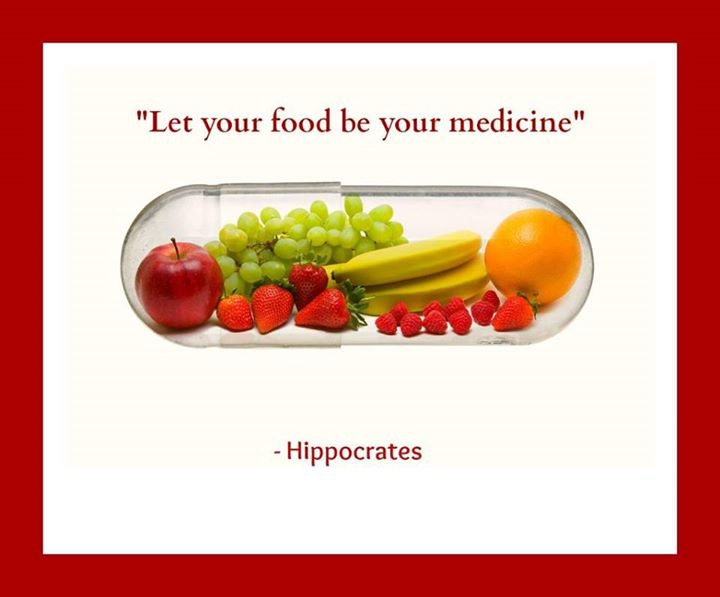
“If you eat to save your heart, you eat to save yourself from other diseases of nutritional extravagance: from strokes, hypertension, obesity, osteoporosis, adult-onset diabetes, and possibly senile mental impairment, as well. You gain protection from a host of other ailments that have been linked to dietary factors, including impotence and cancers of the breast, prostate, colon, rectum, uterus, and ovaries. And if you are eating for good health in this way, here’s a side benefit you might not have expected: for the rest of your life, you will never again have to count calories or worry about your weight.” Dr. Caldwell Esselstyn (full book excerpt)
Learn how to systematically become a healthy plant-based eater in just two months. Click HERE to learn more.
Additional Resources
• Alkalizing the Body is Oxygenating the Body

{ 9 comments… read them below or add one }
Super post! Thanks for all the great resources, love it when I can add more vegan recipes to my pinterest feed 😉
Glad you enjoyed it Angie!!! Thanks for taking the time to read & comment!
Chock full of excellent info. Thanks, Carla. Sharing with friends.
Awesome Karen! Glad you found the post useful and worthy of sharing with your friends. I appreciate you taking time to read & comment.
why have you removed Dr. Thomas Campbell and work which might relate to him from your sources?
Dr. Thomas Campbell’s link is crossed out because his website changed links and the link I originally used is now broken. Dr. Campbell is a valid resource. I encourage referencing his material.
We should eat a healthy diet in our younger age so stay fit and also it will help us in
fighting with diseases.
Yes, these habits and diseases start to form early in life.
Yes, I agree with you, Carla, This is the reason I encourage teenagers around me to eat healthy food and do exercise.